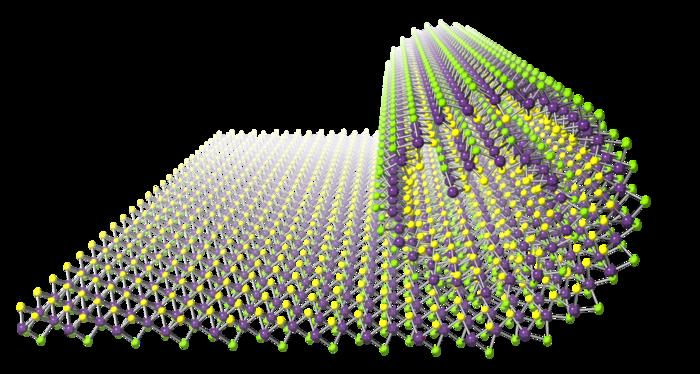Tokyo Metropolitan University scientists have developed a novel method for creating “nanoscrolls” out of atomically thin sheets of atoms. Their novel method creates a tight roll that results in scrolls with a central diameter of five nanometers and a length of micrometers by using transition metal dichalcogenide sheets with a distinct composition on either side. These scrolls provide new opportunities for photovoltaic and catalytic device development due to their controllable nanostructure.
 By replacing the atoms on one side of the nanosheet with a different element, the team have realized a nanosheet that can spontaneously roll into a scroll when detached from its substrate. Image Credit: Tokyo Metropolitan University
By replacing the atoms on one side of the nanosheet with a different element, the team have realized a nanosheet that can spontaneously roll into a scroll when detached from its substrate. Image Credit: Tokyo Metropolitan University
With the help of nanotechnology, engineers will have new tools at their disposal to manipulate the structure of materials at the nanoscale, enabling them to design materials and devices of the future.
Leading this movement is a group headed by Tokyo Metropolitan University’s Associate Professor Yasumitsu Miyata, who has been researching ways to manipulate the structure of transition metal dichalcogenides (TMDC), a class of compounds with a variety of intriguing characteristics, including superconductivity, flexibility, and unique optical absorbance.
Their most recent study focuses on developing novel techniques for creating nanoscrolls, which are structures made of nanosheets folded into tight spirals. This method of creating multi-walled constructions is appealing since the orientations of the separate layers line up with each other because every sheet has the same structure. However, there are serious problems with the two methods currently used to create nanoscrolls.
In one, the removal of sulfur atoms from the nanosheet’s surface results in distortions that induce the sheet to roll up, but they also damage the sheet’s crystal structure. In the alternative, the development of flawless nanoscrolls is made possible by the introduction of a solvent between the nanosheet and the substrate, which loosens the sheet from the base. These types of tubular constructions, however, typically have huge diameters.
Rather than employing methods such as these, the group has devised a novel way to make the sheets roll up. These structures, named after the ancient two-faced god Janus, are created by treating a monolayer molybdenum selenide nanosheet with plasma and replacing the selenium atoms on one side with sulfur.
The sheets are then gently separated from the base by the addition of a solvent, and because of the asymmetry between the surfaces, they begin to naturally roll into scrolls.
These novel nanoscrolls are far longer than previously produced single-walled TMDC nanosheets, measuring several microns in length. In addition, it was discovered that they were rolled more tightly than ever before, matching theoretical predictions with a core as small as five nanometers in diameter. It was also discovered that the scrolls had the ability to produce hydrogen and that they interacted significantly with polarized light.
With unparalleled control over nanostructure, the team’s novel technology lays the groundwork for investigating new uses of TMDC nanoscrolls in catalysis and photovoltaic devices.
Journal Reference:
Kaneda, M., et. al. (2024) Nanoscrolls of Janus Monolayer Transition Metal Dichalcogenides. ACS Nano. doi:10.1021/acsnano.3c05681